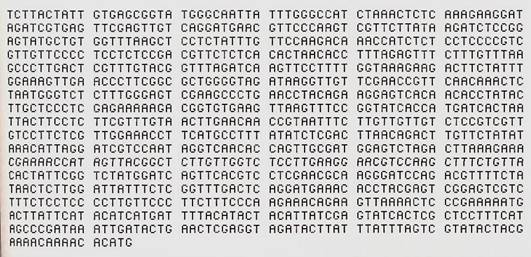

النبات

مواضيع عامة في علم النبات

الجذور - السيقان - الأوراق

النباتات الوعائية واللاوعائية

البذور (مغطاة البذور - عاريات البذور)

الطحالب

النباتات الطبية


الحيوان

مواضيع عامة في علم الحيوان

علم التشريح

التنوع الإحيائي

البايلوجيا الخلوية


الأحياء المجهرية

البكتيريا

الفطريات

الطفيليات

الفايروسات


علم الأمراض

الاورام

الامراض الوراثية

الامراض المناعية

الامراض المدارية

اضطرابات الدورة الدموية

مواضيع عامة في علم الامراض

الحشرات


التقانة الإحيائية

مواضيع عامة في التقانة الإحيائية


التقنية الحيوية المكروبية

التقنية الحيوية والميكروبات

الفعاليات الحيوية

وراثة الاحياء المجهرية

تصنيف الاحياء المجهرية

الاحياء المجهرية في الطبيعة

أيض الاجهاد

التقنية الحيوية والبيئة

التقنية الحيوية والطب

التقنية الحيوية والزراعة

التقنية الحيوية والصناعة

التقنية الحيوية والطاقة

البحار والطحالب الصغيرة

عزل البروتين

هندسة الجينات


التقنية الحياتية النانوية

مفاهيم التقنية الحيوية النانوية

التراكيب النانوية والمجاهر المستخدمة في رؤيتها

تصنيع وتخليق المواد النانوية

تطبيقات التقنية النانوية والحيوية النانوية

الرقائق والمتحسسات الحيوية

المصفوفات المجهرية وحاسوب الدنا

اللقاحات

البيئة والتلوث


علم الأجنة

اعضاء التكاثر وتشكل الاعراس

الاخصاب

التشطر

العصيبة وتشكل الجسيدات

تشكل اللواحق الجنينية

تكون المعيدة وظهور الطبقات الجنينية

مقدمة لعلم الاجنة


الأحياء الجزيئي

مواضيع عامة في الاحياء الجزيئي


علم وظائف الأعضاء


الغدد

مواضيع عامة في الغدد

الغدد الصم و هرموناتها

الجسم تحت السريري

الغدة النخامية

الغدة الكظرية

الغدة التناسلية

الغدة الدرقية والجار الدرقية

الغدة البنكرياسية

الغدة الصنوبرية

مواضيع عامة في علم وظائف الاعضاء

الخلية الحيوانية

الجهاز العصبي

أعضاء الحس

الجهاز العضلي

السوائل الجسمية

الجهاز الدوري والليمف

الجهاز التنفسي

الجهاز الهضمي

الجهاز البولي


المضادات الميكروبية

مواضيع عامة في المضادات الميكروبية

مضادات البكتيريا

مضادات الفطريات

مضادات الطفيليات

مضادات الفايروسات

علم الخلية

الوراثة

الأحياء العامة

المناعة

التحليلات المرضية

الكيمياء الحيوية

مواضيع متنوعة أخرى

الانزيمات
Introduction to Genetics and Evolution
المؤلف:
AN INTRODUCTION TO PLANT BIOLOGY-1998
المصدر:
JAMES D. MAUSETH
الجزء والصفحة:
19-10-2016
2814
Introduction to Genetics and Evolution
Genetics is the science of inheritance. The chemical basis of genetic inheritance is the gene, the sequence of DNA nucleotides that guides the construction of RNA and proteins and also controls the construction of more copies of the genes themselves. If all plants of a species had exactly identical nucleotide sequences in their DNA, then all those plants would be identical physically. But virtually all genes occur in multiple forms known as alleles, the alleles of a particular gene differing from each other in their sequence of nucleotides (Fig. 1).

FIGURE 1: This is one of numerous alleles of the gene that codes for the storage protein glycinin in soybeans. Each allele varies slightly in the sequence of nucleotides, and, as a result, produces a slightly different form of protein. Although each allele has a unique sequence, they are considered variations of the glycinin gene rather than distinct genes, because they all produce more or less the same protein at the same time, in the same place. See Figure 15.4 for alleles of the histone H4 gene.
Alleles arise by mutation; if the nucleotide sequence is changed (mutated) in any way, the new sequence is a new allele. Mutations can occur in any gene in any individual, so gradually a population of separate plants comes to have a variety of alleles. The types of alleles that a single individual has are called its genotype, and the expression of these alleles in the individual's size, shape, or metabolism is its phenotype (Fig. .2). As a result of mutations, the population of individuals has varying genotypes and phenotypes. They are not identical, as is apparent from considering humans.

FIGURE 2:Flower color in four o'clocks (Mirabilis jalapa) is controlled in part by a gene that has two alleles. The DNA sequence of one results in a protein whose primary and tertiary structures cause it to synthesize red pigment. The DNA sequence of the other allele codes for a protein whose tertiary structure is mis-formed; it has no enzymatic activity and no pigment is produced, so flowers are white. If only a small amount of pigment is produced, the flower is pink. Flower color is the plant's phenotype; the type of alleles present is its genotype. (R. Calentine)
An important concept of inheritance is the selective advantage of reproduction, which may be either sexual or asexual . In asexual reproduction, each offspring is identical to its parent and its siblings, having exactly the same DNA and thus the same alleles. Although this might seem like the safest, most efficient mechanism for producing large numbers of offspring to carry the parent's genes into future generations, it is effective only for the genotype and phenotype that have the greatest survival value. During a drought, plants with poor capacity to withstand water stress are outcompeted by plants who* alleles confer superior water stress resistance. During an infestation of pathogenic fungi, individuals without alleles that confer immunity are destroyed. There may be no individual resistant to both stresses.
Sexual reproduction is a mechanism by which an organism combines its alleles with the® of other, possibly better-adapted individuals, thereby increasing the probability that copies of its own alleles survive. If a plant is susceptible to drought, sexual reproduction is advantageous because some of its sex cells may fuse with those of a drought-resistant plant.
If so, the new zygote should grow into an individual resistant to water stress, thus adding some protection to the alleles derived from the susceptible parent. Although the original plant may die during a drought, copies of its alleles survive in its progeny, protected by alleles from the resistant parent (Fig.3). The second parent should benefit as well, as it is almost certainly not superior in all attributes. The drought-sensitive parent may carry alleles for resistance to fungal attack which, during times of fungal attack, protect the alleles of the drought-resistant parent in the offspring, making the progeny of this sexual reproduction resistant to both fungi and water stress.

FIGURE 3: (a) A population probably contains a diversity of genotypes and phenotypes. (b) Without sexual reproduction, selectively advantageous alleles of one individual cannot be combined with those of another, and multiple stresses might kill all individuals. (c) With sexual reproduction, traits of one individual are combined with those of another, often producing individuals more fit than either parent.
Sexual reproduction involves a large degree of chance and risk. Fitness and survival capacity are not governed by just one or two genes, but by almost all genes, including those responsible for the proper construction of membranes, the functioning of organelles, production and transport of hormones, and so on. One cannot say that any aspect is trivial and does not matter. Therefore, the presence of one or two particular alleles in a sex cell is not the key feature, but rather the combination of all the alleles. Because of synapsis and crossing-over in meiosis, each plant produces thousands of types of sex cells, each with a unique genotype, which then fuse with the sex cells of many other individuals. For example, wind-pollinated trees produce millions of pollen grains that blow away and fertilize ovules on hundreds of trees; simultaneously, its own ovules are receiving wind-borne pollen from numerous trees. As a result, thousands of fertilizations may occur that involve this one plant's alleles. Many may produce poor combinations of alleles that have little survival value, but at least a small percentage should have the best attributes of both parents and should produce healthy, genetically sound plants with a high capacity to survival all stresses. It is not necessary or even advantageous for all potential progeny to survive, only the most fit. The plants and animals around us today are the successful survivors of evolutionary experimentation.
 الاكثر قراءة في مواضيع عامة في علم النبات
الاكثر قراءة في مواضيع عامة في علم النبات
 اخر الاخبار
اخر الاخبار
اخبار العتبة العباسية المقدسة

الآخبار الصحية















 قسم الشؤون الفكرية يصدر كتاباً يوثق تاريخ السدانة في العتبة العباسية المقدسة
قسم الشؤون الفكرية يصدر كتاباً يوثق تاريخ السدانة في العتبة العباسية المقدسة "المهمة".. إصدار قصصي يوثّق القصص الفائزة في مسابقة فتوى الدفاع المقدسة للقصة القصيرة
"المهمة".. إصدار قصصي يوثّق القصص الفائزة في مسابقة فتوى الدفاع المقدسة للقصة القصيرة (نوافذ).. إصدار أدبي يوثق القصص الفائزة في مسابقة الإمام العسكري (عليه السلام)
(نوافذ).. إصدار أدبي يوثق القصص الفائزة في مسابقة الإمام العسكري (عليه السلام)


















